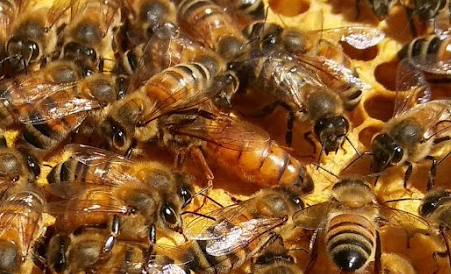So, you finally have some beehives in your backyard (notice I said hives, because you should most definitely get more than one to start with). You probably can’t stop thinking about them, worrying about them and being curious as to what it is they’re doing in there. A lot of beekeepers will tell you not to get into your bees more than once every two weeks. I think otherwise, the more time you spend with your bees the quicker you get used to inspecting your hives, and the more comfortable you get picking up those frames and trying to find the queen.
In a normal hive inspection your main goal(s) are to confirm the queen’s existence and gauge whether they need more space or food. The second and third goals are fairly easy, if there are bees covering every frame, or if you don’t find any empty cells ready for eggs, they probably need another box. Just place one on the top of the stack and come back in a week to check their progress. If your bees need to draw a lot of comb out, or if it’s too early in the year to allow them to fend for themselves, you should be feeding either sugar water (1:1 in spring, 2:1 sugar to water in fall) or honey. They can’t draw out comb without some type of influx of sugar, so feed them as much as they will take until there are enough blooming flowers offering nectar.
As far as finding the queen, that can be tricky. The elation felt when you find her, and know certainly that she is healthy and laying, is second to none as far as I am concerned. Although, there will be times when you just simply cannot find her, she may be hiding, under other bees, on the walls of the box or maybe you just didn’t notice her in the hordes of bees walking happily across the frame. In that case, you should be looking for eggs. Eggs can also be tricky to see, so you should place your back to the sun, allowing the sunlight to shine right into the cells, this will illuminate the tiny white speck in the bottom of the cell. If you find fresh eggs you can rest assured that she was there within the last couple of days, put the hive back together and come back a week later to search again.
Eggs in cells


If you absolutely must find her, whether to make a split, grab her for marking or you just aren’t sure if she is there at all, there are some tips to help you find her.
First, make sure to check both sides of every frame you pull out, watch the bees walk along the top side and look for a gap in the chaos. Worker bees will part when the queen is walking, careful not to impede her in her quest to find empty cells ready for an egg. If you train your eyes to look for that part, and not look at the individual bees, she can pop out to you like the image in one of those trick your eye pictures.
If looking for the bees parting ways does not help, look into the box and start pulling out the most densely populated frames. Not only is the queen always accompanied by attendant bees, but wherever she is laying eggs, there are nurse bees ready to tend to the young. Often you will find those densely populated frames directly in the middle of the box.
Throughout this whole process, be sure to pull frames out without rubbing the bees against the box or adjacent frames, through that mistake you can “Roll” the queen, injuring her and sealing her doomed fate. To make avoiding that problem easier, always remove the first frame you inspect and set it to the side, outside of the box, that allows for more maneuvering room for the rest of the frames.
The bottom line as far as finding the queen is, sometimes it’s funny how easy it is, and others it seems an impossible task. Take your time, go methodically from frame to frame and try not to get frustrated. If your bees are calm and you see young brood, chances are she is in there but just not ready for her closeup, Mr. Demille.



